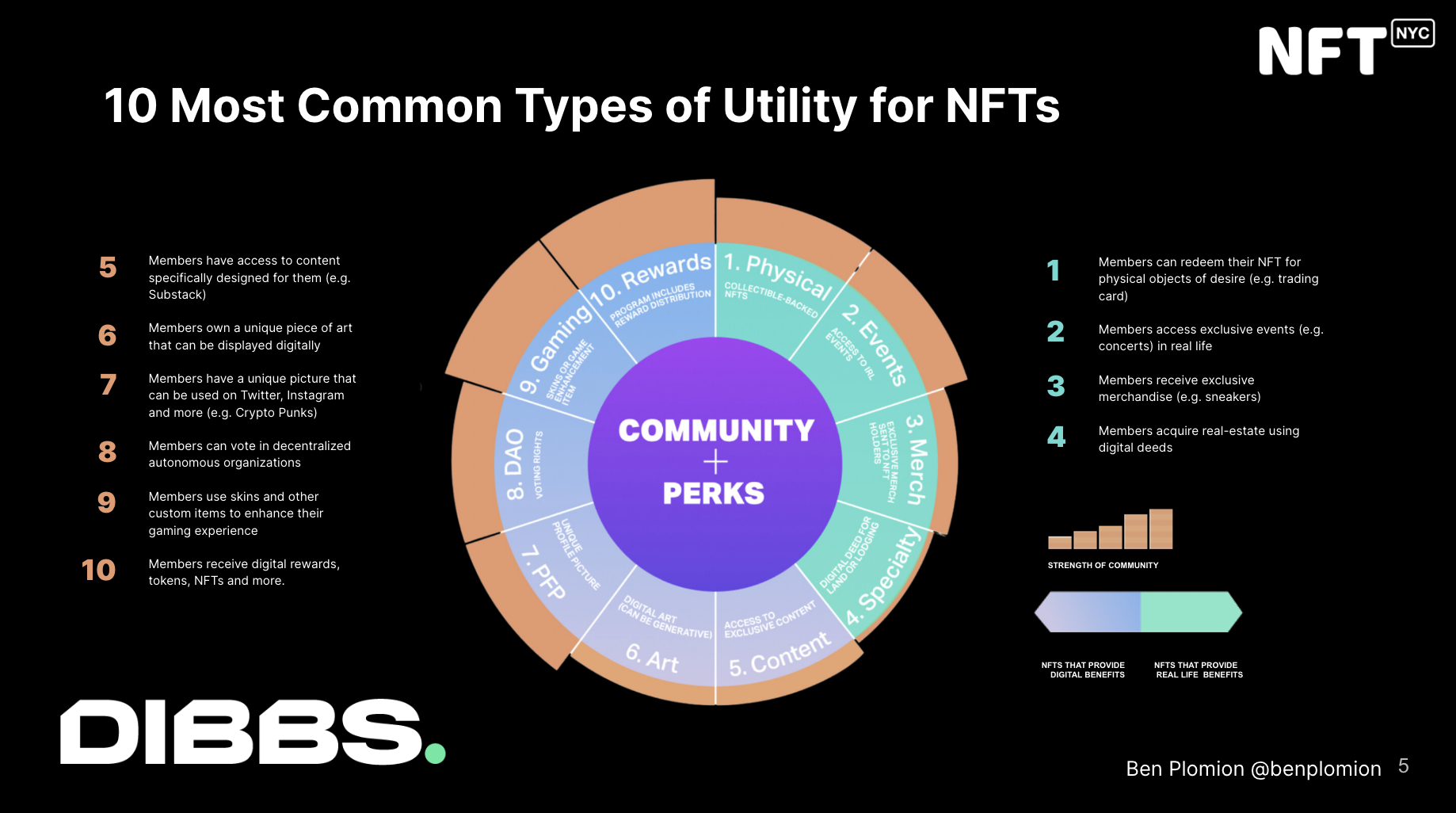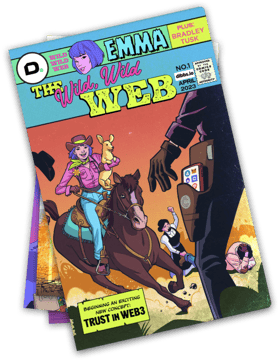The 10 Types of NFT Utility
NFTs aren’t just digital art — they can be used for event access, land deeds, and much more

NFTs (non-fungible tokens) have become a foundational part of the internet’s web3 future in the few short years since they burst onto the scene. While some still see them as fancy jpegs (or, more accurately, pngs), the truth is that NFTs are much more than digital pictures. With NFT utility, brands can offer unique ways to engage audiences, ranging from proof of ownership of physical goods to access passes for major events. By the time you’re finished with this article, you’ll understand the major types of NFT utility as they exist today.
What Is NFT Utility?
NFT utility is a set of functions that an NFT has that allows it to be used as something other than a piece of unique digital artwork. Utility NFTs may grant someone access to an event, include a smart contract for ownership of a physical good, or even give the owner voting rights within an organization. Like most goods, the more utility an NFT has, the more it's potentially worth. An NFT isn’t limited to a single use case; it can be a grab bag of utility with both digital and real-life functions.
Types of Real-Life NFT Utility
While most people associate NFTs with digital goods, there are types of NFT utility that have benefits in the real world. These NFTs will typically provide access to a location, indicate ownership of a physical item, or have some other benefit offline.
Collectible-Backed NFTs
Have you ever wanted to sell iconic pieces of memorabilia, art, or other physical goods from your organization’s history, but found it impractical to do so? That’s where collectible-backed NFTs come into play. These NFTs are backed by physical items that’s insured and stored somewhere that’s both secure and temperature controlled. NFTs are then minted that represent ownership of the physical items, which can then be sold to collectors. Collectible items can be anything from a set of collectible trading cards to guitars signed by Jeff Beck.
Certain creators receive a royalty payment any time the NFT is resold on secondary markets, which makes them a perfect way to earn a continuous stream of income. NFTs aren’t restricted to a particular territory, either, so collectible-backed NFTs are an easy way to penetrate the 24/7 global market. Not only does that mean trades — and royalty payments — happen more frequently, but it also increases brand awareness in territories that organizations may not have otherwise considered.
Dibbs can help bring your memorabilia to life as a collectible-backed NFT. Partner with us to see how your fan-favorite collectibles can find new life as NFTs.
Subscribe to get our best content in your inbox
By clicking “Submit” you agree to Dibbs
Privacy Policy and
consent to Dibbs using your contact data for newsletter purposes.

Access to IRL Events
Event access has been one of the more common ways that organizations use utility NFTs. These NFTs grant the holder access to real-world events, such as concerts, festivals, or exclusive meet-and-greets. Only the NFT holder can redeem the event access ticket, with the blockchain verifying that they’re the one that purchased it. The digital, confirmation-backed public ledger nature of the blockchain dramatically reduces the risk of the NFT and its associated event access being lost or stolen.
Exclusive Merch
With consumer loyalty at an all-time high, building hype around new, exclusive product launches has become much easier. NFTs offer an easy way for brands to sell exclusive merch, acting as a redeemable ticket for the merchandise that can be transferred between buyers before being redeemed.
Essentially, it streamlines systems like secondary sneaker markets, where exclusive drops sell out in minutes. Buyers and sellers don’t have to worry about moving the physical merchandise around because it won’t ship until the token is redeemed, and the NFT creator earns a royalty for each sale. It’s worth noting that 84% of NFT enthusiasts would purchase an NFT if it were redeemable for a physical item.
Digital Deeds for Land or Lodging
Yes, utility NFTs can act as digital land deeds. Roofstock recently made history, making the first house sale as an NFT on OpenSea. The NFT sold for $175,000 and gives ownership to a 3-bedroom house in South Carolina. Web3 tech is being used more and more to simplify homeownership and access to digital assets. While the real estate industry in the US has been slow to adopt NFTs, they’ve got a lot of potential for the future. Real estate is capital intensive, but NFTs could be used to buy and shouse up for sale as an NFTell property stakes, allowing investors to own portions of a property’s profit.
Types of Digital NFT Utility
In the digital landscape, there’s seemingly no end to how NFTs can be used. Marketers can leverage the various forms of digital NFT utility to provide their customers with unique experiences, behind-the-scenes content, and even voting rights that help chart an organization’s future.
Access to Exclusive Digital Content
NFTs can be used to access gated digital content on a website or within an online community. The token-gated content can be practically anything, from exclusive webinars to bonus episodes of a TV show. For instance, you could sell an NFT movie ticket that allows users to watch a film before it hits theaters with limited access. It makes each NFT a commodity and provides an exciting experience in return.
Digital Art
AI-generated art has been making waves recently, but autonomously created artwork has been a defining aspect of NFTs for years. Called Generative Art, NFTs can be used to create impressive artworks that give modernists a run for their money. These works often feature striking geometric shapes and remarkable intentionality behind each pixel-crafted brushstroke. Even on their own, these works of art can be turned into collections that fans can buy, sell, and trade.
Unique Profile Pictures
NFT profile pictures are possibly the most prominent way that NFTs have been used. Grinning apes in sailor’s hats — part of the popular Bored Ape Yacht Club collection — have become common on social media websites along with countless lines of NFT artwork. Some social media websites, like Twitter, officially support setting NFTs as profile pictures, connecting your account to your crypto wallet and changing how your profile picture is displayed.
Unique profile pictures are a great way to spread brand awareness. They’re akin to word-of-mouth advertising, though it has the added benefit of featuring a visual element as an attention grabber.
Voting Rights
One of the most intriguing forms of NFT utility grants NFT owners the ability to vote on measures, strategy, and more within an organization. These organizations, called Decentralized Autonomous Organizations (DAO), give voting power in proportion to the number of DAO-supported NFTs or cryptocurrencies an individual owns. For example, anyone that owned 51% of the NFTs for a DAO could win a majority vote without fail.
These NFTs don’t have to be used for votes on major organization policies. Rather, they can be used for entertaining polls that help build stronger bonds within a community. For instance, a band with NFTs that grants voting rights could allow the holders to vote on a set list for a digital concert.
Skins or Other In-Game Enhancements
NFT video games are still in their early days, but skins and other in-game enhancements have emerged as a primary way for game developers to empower players’ self-expression. NFT skins let players give their avatars completely unique looks, weapons, and more. They also present an opportunity for branded deals, allowing game developers to attract fans of other IP.
Rewards Distribution Programs
Last but not least, NFTs can be used as part of a rewards distribution program. In this structure, the NFTs are handed out for achieving certain milestones or objectives. For instance, you could distribute NFTs to loyal customers after they reach a spending milestone. The recipient can then choose to keep or sell the NFT. If they opt to sell it, the NFT creator will receive a royalty payment, which makes them a desirable alternative to traditional reward structures.
While these are the most prominent forms of NFT utility, more are being regularly discovered, and experienced NFT partners are here to help you create utility NFTs of your own. Schedule a demo of Dibbs’ tokenization solution to activate your brand’s Web3 marketing strategy, give your consumers exciting new ways to connect with you, and create communities around your collectibles, all while safeguarding your brand’s legacy.

Ben Plomion
Ben Plomion is Dibbs' Chief Marketing Officer. As a child, Ben collected comic books and Panini Football stickers. Now, Ben's PC consists of physical-backed NFTs.

